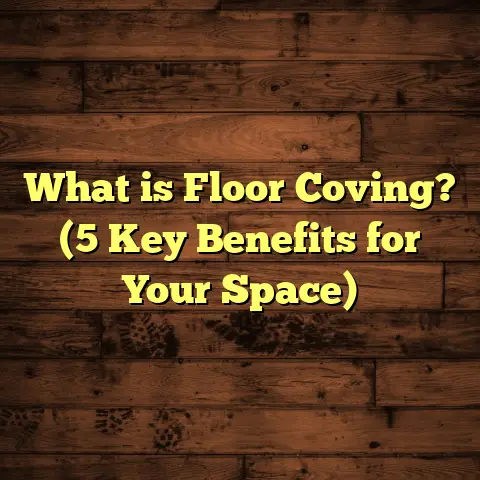What is Timber Flooring? (5 Reasons to Choose Wood!)
I still remember the smell of my grandmother’s old wooden floors—the subtle scent of aged oak mixed with a faint hint of wax polish. It was one of those sensory things that always brought a smile to my face. Walking barefoot on those floorboards felt like stepping into a cozy storybook filled with warmth and history. That feeling stuck with me through all my years working as a flooring contractor. Timber flooring isn’t just about covering a space; it’s about bringing character and life to your home.
If you’ve ever wondered what timber flooring is exactly or why so many people swear by it, I’d love to share some insights from my experience. I’ll guide you through the basics of timber floors, share stories from the field, reveal some stats, and give you practical tips for making your own wood floor project a success.
What is Timber Flooring?
Timber flooring is simply flooring made from natural wood. The term “timber” typically refers to wood that has been processed for construction or flooring purposes. When we talk about timber flooring, we mean wooden planks or boards that are used as the surface layer on floors in homes, offices, or commercial spaces.
Types of Timber Flooring
There are two primary types of timber flooring you’ll encounter:
1. Solid Hardwood Flooring:
This is made from a single piece of wood, usually between 18-20mm thick. Each plank is cut straight from a tree trunk. Because it’s solid wood throughout, it can be sanded and refinished multiple times over its lifespan. Solid hardwood is prized for its authenticity and durability but can be sensitive to moisture and temperature fluctuations.
2. Engineered Hardwood Flooring:
Engineered timber consists of a top layer of real wood veneer glued over several layers of plywood or fiberboard. This layered construction offers greater stability, especially in environments where humidity changes are common. Engineered wood can mimic the look and feel of solid hardwood but often comes at varying price points depending on the thickness of the veneer and quality of construction.
How Timber Flooring is Made
The process starts with selecting the right species of tree—some woods are harder, some softer, some lighter, and some darker. After harvesting, logs are milled into planks and dried to remove moisture, which helps prevent warping later on.
Then comes sanding and finishing. The finish protects the wood from wear and tear while enhancing its natural beauty. There are different types of finishes like polyurethane (available in oil-based or water-based), wax, and oil.
Why Timber Flooring?
Timber floors have been around for centuries because they offer something uniquely appealing—a connection to nature combined with durability and elegance. You might ask: “Isn’t laminate or vinyl more affordable?” True, they can be cheaper upfront. But timber offers benefits that synthetic floors just can’t match.
1. Timeless Beauty That Only Gets Better Over Time
One of the things I love most about timber floors is how they transform over the years. Unlike many other materials that deteriorate or lose their charm, wood actually ages gracefully.
When I installed timber flooring in a renovated Victorian home last year, the owners were blown away by how the floor’s color deepened after refinishing. The grain became more pronounced, adding texture to their living room in a way no carpet could replicate.
The Patina Effect
This “patina” is something special—wood develops a soft glow as it ages because natural oils rise to the surface and interact with light. It’s like a fine wine improving in the cellar over decades.
According to the National Wood Flooring Association (NWFA), solid hardwood floors can last well over 100 years if properly maintained. That means your floor could literally become a family heirloom.
Unique Character
No two timber floors are alike because each plank carries its own grain patterns, knots, and color variations. This uniqueness brings personality into any room.
Here’s a fun fact: Did you know that many luxury hotels and historic buildings invest in reclaimed timber flooring to add authenticity? They want floors that have been “lived on” before because they tell a story.
2. Healthier Indoor Air Quality
Carpets trap dust mites, pet dander, mold spores—the usual suspects behind allergies and asthma flare-ups. I’ve seen families switch from carpet to timber floors to help improve breathing conditions at home.
One client with severe allergy concerns told me she finally felt relief after her carpets were replaced with oak planks. Her house felt fresher; her son’s nighttime coughing reduced dramatically.
Scientific Evidence Behind Wood Floors & Allergies
Studies support what I’ve seen firsthand. Research published by Allergic Living shows that hardwood floors reduce airborne allergens by about 50% compared to carpeted rooms.
Why? Because wood doesn’t absorb dust and allergens like fibers do. Plus, cleaning becomes simpler—regular sweeping or vacuuming removes particles instead of trapping them.
If you or someone in your household suffers from asthma or allergies, timber flooring could significantly improve your indoor air quality without sacrificing style.
3. Versatility in Design — Fits Any Style
Are you someone who likes to change your decor every few years? Timber flooring makes it easy to adapt your space without ripping up your floors.
From light blonde maples perfect for Scandinavian minimalism to richly colored mahogany ideal for classic traditional homes, there’s a species and finish for every taste.
Species & Colors
Here’s a quick breakdown of popular timber species and their looks:
| Species | Color Range | Hardness (Janka scale) | Style Vibe |
|---|---|---|---|
| Oak | Light tan to medium brown | 1290 | Classic & versatile |
| Maple | Pale cream to light reddish | 1450 | Modern & clean |
| Walnut | Dark brown with purple hues | 1010 | Warm & luxurious |
| Hickory | Varied light/dark contrasts | 1820 | Rustic & durable |
| Cherry | Reddish-brown darkening with age | 950 | Elegant & rich |
Janka hardness measures how resistant wood is to dents; higher means harder.
Finishes for Every Personality
Want a matte finish for understated elegance? Go for water-based polyurethane or hard wax oil.
Love that glossy sheen? Oil-based polyurethane can give you that mirror-like shine but usually requires more maintenance.
I always suggest testing samples in your home lighting before settling—the same wood can look totally different under natural versus artificial light.
4. Durability That Stands Up to Life’s Messes
I’ve installed timber floors in all sorts of environments—from quiet bedrooms to bustling kitchens and even commercial spaces with heavy foot traffic.
Knowing which type of wood and finish suits your lifestyle is key. For example:
- High-traffic areas: Hickory or oak with aluminum oxide finish handle wear well.
- Low-traffic rooms: Softer woods like pine can add charm without worrying too much about dents.
- Homes with pets/kids: I recommend engineered hardwood for better moisture resistance paired with durable finishes.
The Janka Hardness Scale Explained
To give you an idea about wood toughness: the Janka hardness test measures how much force it takes to embed a steel ball halfway into wood.
Here are some numbers for reference:
- Red oak: 1290
- Hard maple: 1450
- Hickory: 1820
- Brazilian cherry: 2350
Choosing a species with higher hardness means better resistance against dents and scratches from daily life activities.
Real-World Durability Stats
In a survey by Houzz involving over 2,000 homeowners, durability ranked as the second most important factor for flooring choice after appearance.
From my experience:
- Properly finished hardwood floors can resist spills, scratches, and scuffs.
- Regular maintenance like refinishing every 7-10 years keeps them looking new for decades.
- Engineered hardwood tends to fare better in kitchens or basements where moisture may be present.
5. Adds Value & Market Appeal to Your Home
Here’s something many homeowners overlook: flooring impacts your property value more than you might think.
Timber floors remain one of the most sought-after features for buyers. Why? Because they signal quality and timelessness.
Hard Data on Home Value Impact
According to Zillow’s housing report:
- Homes with hardwood floors sell for about 2% more than comparable homes without.
- Properties with wood flooring spend fewer days on the market.
- Real estate agents often advise installing wood floors before listing due to strong buyer preference.
I’ve helped clients replace outdated carpets or vinyl with timber before selling their homes, and the feedback was always positive—buyers commented on the warmth and quality feel underfoot.
My Personal Tips for Choosing & Maintaining Timber Floors
Over the years, I’ve learned plenty about what works—and what doesn’t—when it comes to timber flooring projects.
Here are some things I wish I’d known before my first installation:
1. Let Wood Acclimate Before Installation
Wood adjusts to humidity levels by expanding or contracting slightly. Always let your planks sit in the room where they’ll be installed for at least 72 hours beforehand.
This simple step reduces gaps or buckling later on because the wood is already “used” to its environment.
2. Prepare Your Subfloor Carefully
A smooth, level subfloor prevents creaking and uneven wear down the road. I’ve seen installations go sideways because this step was rushed—never skip it!
3. Pick the Right Finish for Your Lifestyle
If you have kids or pets, durability comes first. Water-based polyurethane offers excellent scratch resistance and low VOCs (better air quality).
For those wanting natural looks over gloss, hard wax oils provide protection while preserving the raw feel of wood.
4. Regular Cleaning is Key
Sweep or vacuum regularly using soft brush attachments—this prevents dirt particles from scratching surfaces.
Avoid wet mopping unless you use specially formulated wood floor cleaners that won’t damage finishes.
Case Study: The Johnson Family’s Timber Floor Transformation
The Johnsons had worn-out carpet in their living room and kitchen. With three active kids and two dogs running around, they wanted something tough yet attractive.
We chose engineered oak planks with a matte finish—they loved how it hid scratches while brightening their space with warm tones.
After two years:
- They noticed significantly less dust accumulation.
- No major scratches despite heavy use.
- Easy cleanup after spills.
- Their home felt more inviting and cozy.
This project confirmed what I’ve always believed: timber flooring balances beauty and practicality perfectly when done right.
Frequently Asked Questions About Timber Flooring
Is Timber Flooring Expensive?
Upfront costs vary by species and type but expect $6-$12 per square foot for solid hardwood; engineered options range $4-$10 per square foot depending on quality.
While pricier than laminate or vinyl initially, longevity and value often justify the investment over time.
Can Timber Floors Be Installed Over Radiant Heating?
Yes! Engineered timber is especially suitable for radiant heat systems because it handles temperature changes better than solid hardwood.
How Often Should I Refinish My Timber Floor?
Generally every 7-10 years depending on wear levels—but high-traffic areas might need touch-ups earlier.
Are Timber Floors Environmentally Friendly?
Wood is renewable when sourced responsibly from certified forests (look for FSC certification). Also, timber floors can be recycled or repurposed at end-of-life.
Wrapping Up My Take on Timber Flooring
If you want a floor that offers natural beauty, durability, health benefits, flexibility in design, plus adds value to your home—it’s hard to beat timber flooring.
It’s not just about covering your floor; it’s about creating an environment filled with warmth and personality that grows richer every year you live there.
Got questions or want advice about which type of timber suits your space best? I’m happy to chat anytime—I love helping people find their perfect floor!
Let me know if you want me to share insights on installation techniques or maintenance routines next!





